初中英语课堂教学流程图
- 格式:doc
- 大小:47.00 KB
- 文档页数:8
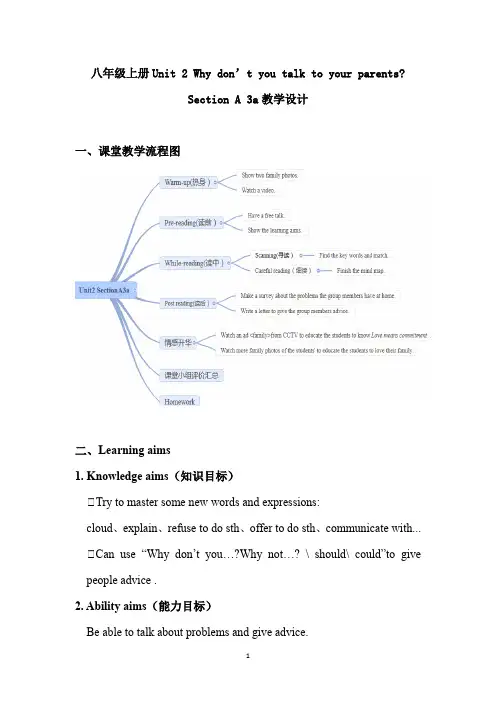
八年级上册Unit 2 Why don’t you talk to your parents?Section A 3a教学设计一、课堂教学流程图二、Learning aims1. Knowledge aims(知识目标)①Try to master some new words and expressions:cloud、explain、refuse to do sth、offer to do sth、communicate with...①Can use “Why don’t you…?Why not…? \ should\ could”to give people advice .2. Ability aims(能力目标)Be able to talk about problems and give advice.3.Emotion aims(情感目标)Be able to understand each other and love the family.4.Key points and difficult points(教学重点、难点)Key points:Master the key words and phrases.Be able to express the problems people have.Be able to give people advice.Difficult points: Be able to use “Why don’t you…?Why not…? \ should\ could” and the phrases to give people advice .三、教学过程设计Part1: Warm-upStep1: Show two family photos of a student.Step2: Enjoy the family photos and the video “I love my family ”.to understand the idea of “Love in a family.”【设计意图】通过展示班里张书豪同学的家庭照片,吸引学生的兴趣,同时为下一步引入Family 的话题做铺垫。
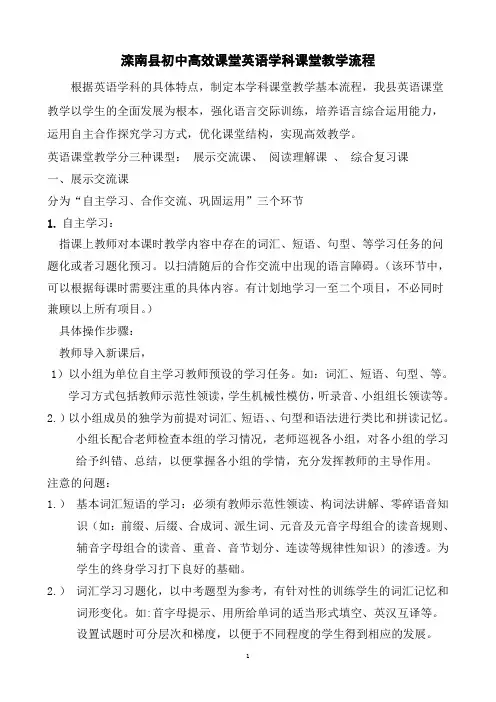
滦南县初中高效课堂英语学科课堂教学流程根据英语学科的具体特点,制定本学科课堂教学基本流程,我县英语课堂教学以学生的全面发展为根本,强化语言交际训练,培养语言综合运用能力,运用自主合作探究学习方式,优化课堂结构,实现高效教学。
英语课堂教学分三种课型:展示交流课、阅读理解课、综合复习课一、展示交流课分为“自主学习、合作交流、巩固运用”三个环节1.自主学习:指课上教师对本课时教学内容中存在的词汇、短语、句型、等学习任务的问题化或者习题化预习。
以扫清随后的合作交流中出现的语言障碍。
(该环节中,可以根据每课时需要注重的具体内容。
有计划地学习一至二个项目,不必同时兼顾以上所有项目。
)具体操作步骤:教师导入新课后,1)以小组为单位自主学习教师预设的学习任务。
如:词汇、短语、句型、等。
学习方式包括教师示范性领读,学生机械性模仿,听录音、小组组长领读等。
2.)以小组成员的独学为前提对词汇、短语、、句型和语法进行类比和拼读记忆。
小组长配合老师检查本组的学习情况,老师巡视各小组,对各小组的学习给予纠错、总结,以便掌握各小组的学情,充分发挥教师的主导作用。
注意的问题:1.)基本词汇短语的学习:必须有教师示范性领读、构词法讲解、零碎语音知识(如:前缀、后缀、合成词、派生词、元音及元音字母组合的读音规则、辅音字母组合的读音、重音、音节划分、连读等规律性知识)的渗透。
为学生的终身学习打下良好的基础。
2.)词汇学习习题化,以中考题型为参考,有针对性的训练学生的词汇记忆和词形变化。
如:首字母提示、用所给单词的适当形式填空、英汉互译等。
设置试题时可分层次和梯度,以便于不同程度的学生得到相应的发展。
3)小组展示学习成果。
展示学习成果可分为口、笔头两种形式。
为节省时间,学习内容可提前以问题或习题的方式设置在学案或者电子白板上。
口头展示只在小组内或者不同组间进行。
不必到教室前面;笔试可展示在前后黑板、或者单词本上。
4)第一课时的词汇学习应侧重学生认读成果展示,随着课时的深入逐步对词汇提高要求。
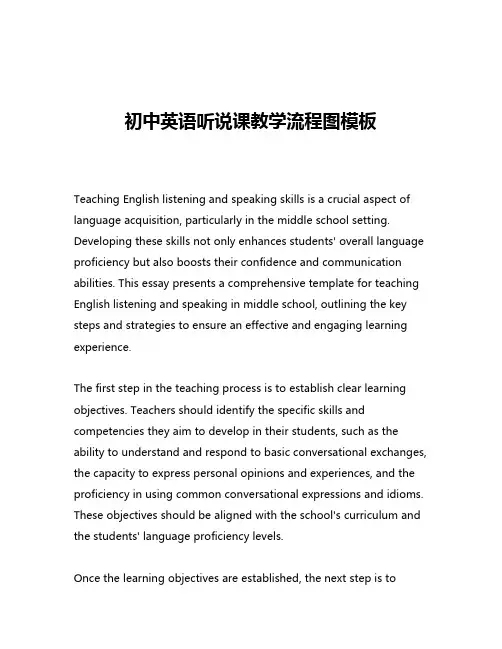
初中英语听说课教学流程图模板Teaching English listening and speaking skills is a crucial aspect of language acquisition, particularly in the middle school setting. Developing these skills not only enhances students' overall language proficiency but also boosts their confidence and communication abilities. This essay presents a comprehensive template for teaching English listening and speaking in middle school, outlining the key steps and strategies to ensure an effective and engaging learning experience.The first step in the teaching process is to establish clear learning objectives. Teachers should identify the specific skills and competencies they aim to develop in their students, such as the ability to understand and respond to basic conversational exchanges, the capacity to express personal opinions and experiences, and the proficiency in using common conversational expressions and idioms. These objectives should be aligned with the school's curriculum and the students' language proficiency levels.Once the learning objectives are established, the next step is todesign a well-structured lesson plan. The lesson plan should incorporate a variety of engaging activities and tasks that cater to different learning styles and preferences. For example, the lesson may begin with a warm-up activity, such as a short dialogue or a listening comprehension exercise, to activate students' prior knowledge and prepare them for the main lesson.The core of the lesson should focus on developing students' listening and speaking skills. This can be achieved through a combination of teacher-led instruction, pair or group work, and individual practice. Teachers can start by introducing new vocabulary and expressions related to the lesson topic, providing clear explanations and examples. They can then move on to listening comprehension exercises, where students are exposed to authentic or semi-authentic audio recordings and are required to answer questions or complete tasks based on the content.To further enhance students' speaking skills, teachers can incorporate various interactive activities, such as role-playing, information-gap exercises, or small-group discussions. These activities should encourage students to engage in meaningful conversations, express their ideas, and respond to their peers' contributions. Teachers should provide constructive feedback and guidance throughout these activities, helping students to improve their pronunciation, fluency, and communication strategies.Throughout the lesson, it is important to incorporate a variety of multimedia resources and technological tools to make the learning experience more engaging and interactive. For instance, teachers can use audio or video recordings, interactive whiteboards, or language learning applications to provide diverse input and facilitate interactive practice.Effective assessment and feedback are crucial components of the teaching process. Teachers should regularly assess students' progress and provide them with constructive feedback to help them identify their strengths and areas for improvement. This can be done through formative assessments, such as in-class observations, quizzes, or short presentations, as well as summative assessments, like end-of-unit tests or oral proficiency exams.In addition to the core lesson components, teachers should also consider incorporating cultural elements into their teaching. Exploring the cultural contexts and social norms associated with the target language can not only enhance students' understanding of the language but also foster their intercultural competence and appreciation for diversity.Finally, it is essential for teachers to create a supportive and inclusive learning environment that encourages students to take risks, makemistakes, and actively participate in the learning process. By fostering a positive and encouraging classroom atmosphere, teachers can help students overcome their fears and inhibitions, ultimately leading to greater language proficiency and confidence.In conclusion, the template for teaching English listening and speaking in middle school presented in this essay provides a comprehensive and structured approach to language instruction. By incorporating a variety of engaging activities, leveraging technology, and fostering a supportive learning environment, teachers can effectively develop their students' listening and speaking skills, preparing them for successful communication in the target language.。
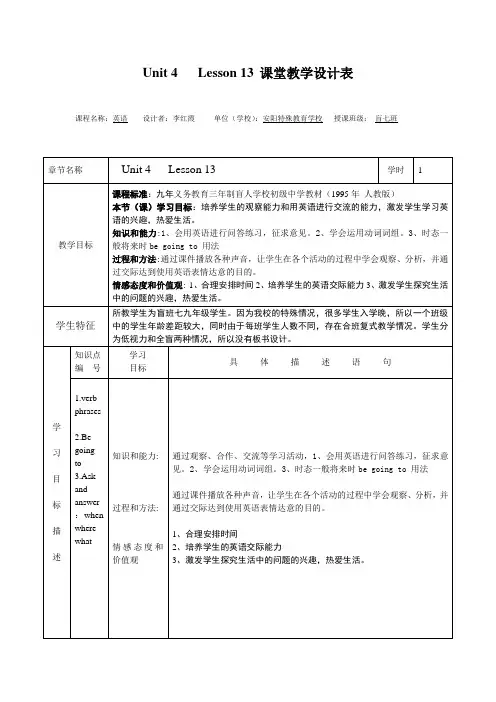

可编辑范本Good afternoon,everybody.Let ’s being our class. Everybody,do you remember Teddy bear song?“teddy bear ’s father ”ready go!thank you!everybody.,sit down please.Today,I’ll got a picture for you. Oh! It ’s a very beautiful picture. Everybody,do you remerber teddy bear ’s family? who are they? Let ’s see ,what ’s happened?The teddy ’s mother said:what do you like to do?do you like to catch the butterfly?The teddy ’s sister said:No,I don ’t.I like to takePhotos. The teddy said:I like to catch the butterfly. The teddy ’s brother said:I like to play KongFu.Everybody.Is it interesting? Today,I ’ll going to learned these sentences.Now,everybody,look at these sentences.What do you like to do? I like to(catch the butterfly\take photos\play KongFua)?This time,I ask,you answer…Let’s change it.you ask, I answer. ready go!...Great,from here,you are the team A,one,two...you are the team B one,two...Now,team A ask,team B answer.ready go! Let’s change it. team A ask, team B answer. ready go!...Now,Let’s play a game.Do you want to play a game?yes!NO.1 come here please.You should say what do you like to do? and do the action.You should guess and say I like to …可编辑范本Today,we have learned what do you like to do? I like to(catch the butterfly\take photos\play KongFua)?I want you exeise these sentence after class.OK,class is over. Thank you.可编辑范本。
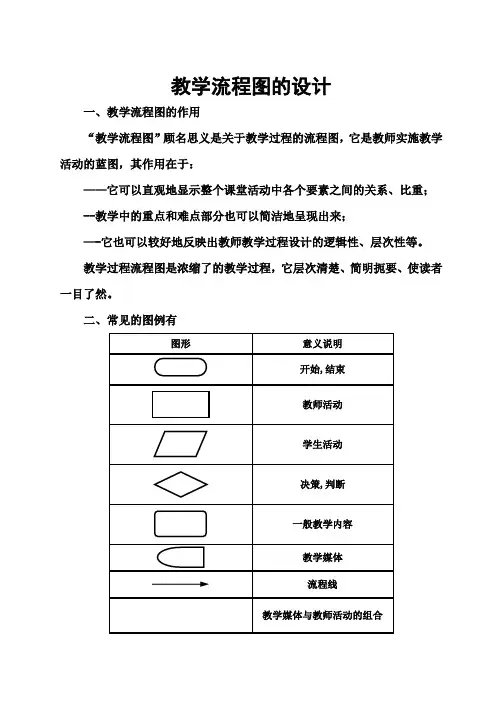
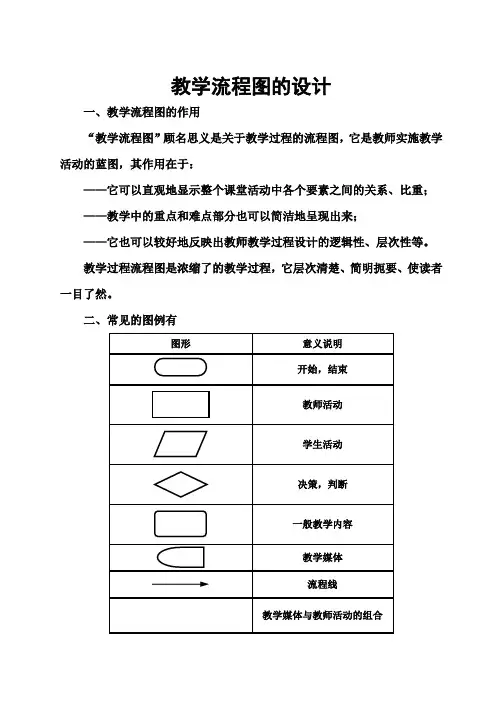
教学流程图的设计
一、教学流程图的作用
“教学流程图”顾名思义是关于教学过程的流程图,它是教师实施教学活动的蓝图,其作用在于:
——它可以直观地显示整个课堂活动中各个要素之间的关系、比重;
——教学中的重点和难点部分也可以简洁地呈现出来;
——它也可以较好地反映出教师教学过程设计的逻辑性、层次性等。
教学过程流程图是浓缩了的教学过程,它层次清楚、简明扼要、使读者一目了然。
二、常见的图例有
教学流程图
学生评价 学生小结
思考练笔材料 课件 学生判断
课堂练笔 课件
教师补充
教师补充
结束。

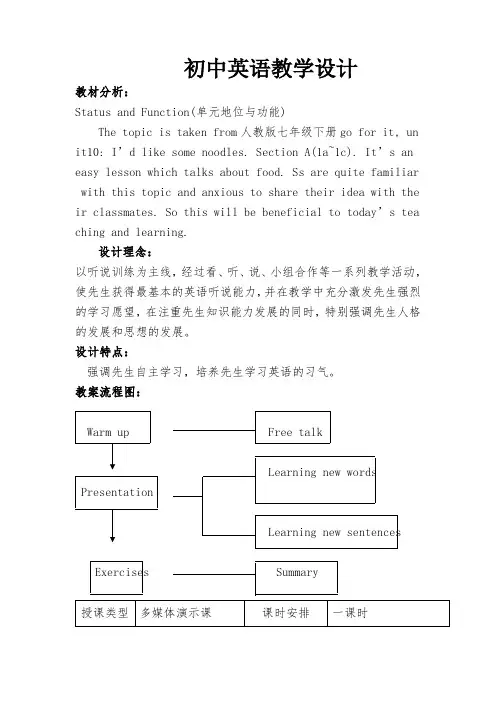
初中英语教学设计教材分析:Status and Function(单元地位与功能)The topic is taken from人教版七年级下册go for it, un it10: I’d like some noodles. Section A(1a~1c). It’s an easy lesson which talks about food. Ss are quite familiar with this topic and anxious to share their idea with the ir classmates. So this will be beneficial to today’s tea ching and learning.设计理念:以听说训练为主线,经过看、听、说、小组合作等一系列教学活动,使先生获得最基本的英语听说能力,并在教学中充分激发先生强烈的学习愿望,在注重先生知识能力发展的同时,特别强调先生人格的发展和思想的发展。
设计特点:强调先生自主学习,培养先生学习英语的习气。
教案流程图:Warm up Free talkLearning new wordsPresentationLearning new sentences Exercises Summary播放短视频关于面条(有点搞笑)1、Free talk:以本人看到的视频为线索组织教学。
Blackboard design:Unit 10 I’d like noodles!教学反思:1、本课力求经过一系列贴近先生生活实践的生动活泼的教学设计,激发先生学习英语的兴味,培养先生自主学习和团结合作的能力,使先生初步构成该话题的会话能力。
2、教学过程中根据先生的心思和生理特点,采用小组合作与教学相结合的方法,同时积极鼓励先生进行情景交际,让先生在教师的指点下经过感知、体验、理论、参与和合作等方式打破教学目标。
3、教学过程中需求改进的是板书设计,本次板书没有触及含量,太单调,好的板书可以起帮助记忆和总结。
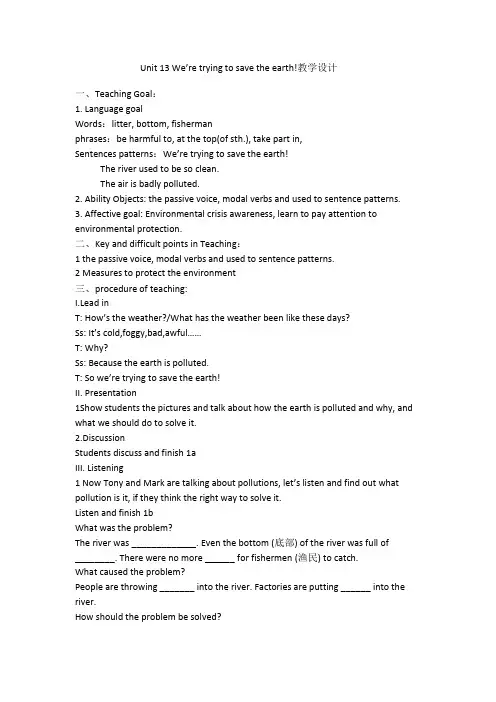
Unit 13 We’re trying to save the earth!教学设计一、Teaching Goal:1. Language goalWords:litter, bottom, fishermanphrases:be harmful to, at the top(of sth.), take part in,Sentences patterns:We’re trying to save the earth!The river used to be so clean.The air is badly polluted.2. Ability Objects: the passive voice, modal verbs and used to sentence patterns.3. Affective goal: Environmental crisis awareness, learn to pay attention to environmental protection.二、Key and difficult points in Teaching:1 the passive voice, modal verbs and used to sentence patterns.2 Measures to protect the environment三、procedure of teaching:I.Lead inT: How’s the weather?/What has the weather been like these days?Ss: It’s cold,foggy,bad,awful……T: Why?Ss: Because the earth is polluted.T: So we’re trying to save the earth!II. Presentation1Show students the pictures and talk about how the earth is polluted and why, and what we should do to solve it.2.DiscussionStudents discuss and finish 1aIII. Listening1 Now Tony and Mark are talking about pollutions, let’s listen and find out what pollution is it, if they think the right way to solve it.Listen and finish 1bWhat was the problem?The river was _____________. Even the bottom (底部) of the river was full of________. There were no more ______ for fishermen (渔民) to catch.What caused the problem?People are throwing _______ into the river. Factories are putting ______ into the river.How should the problem be solved?We should write to the ____________ and ask them to ___________ the factories. Everyone should help to __________ the river.IV. Show Time1 T: I don’t think it’s enough. You’re not deeply moved. Now I’ll show you something. After watching, tell me your feeling.Let students watch the MV.2 Then ask them to draw small pictures to show their feeing and what they can doto protect our earth.V. HomeworkPlease make a poster and think of what we can do.VI. ConclusionWrite on the blackboardUn it 13 We’re trying to save the earth!1 litter n/v rubbish air pollution2 fisherman pl fishermen noise pollutionwater pollution。
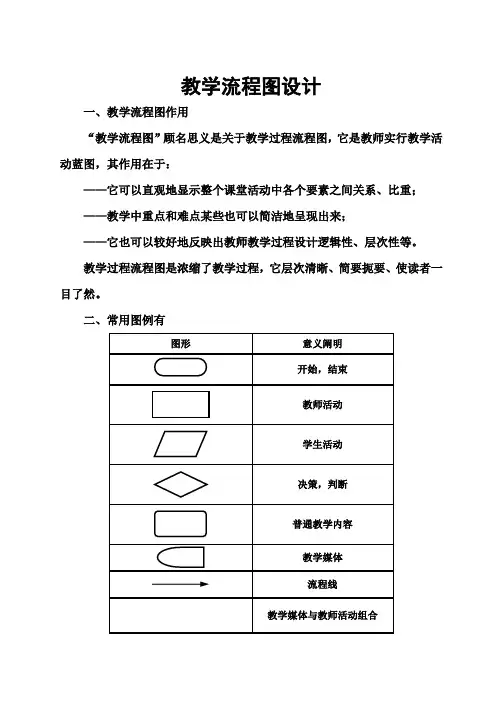
初中英语教学计划示意图引言:初中英语教学计划是教师制定教学活动的重要指导,合理的教学计划能够提高教学效果,培养学生的英语综合能力。
本文将从教学主题、活动安排、教材使用等方面进行展开,探讨中学英语教学计划的设计与实施。
一、教学主题:教学主题的确定需要根据学生的年龄特点和英语学科的特点进行。
在初中阶段,学生的英语学科要求更多地强调基础知识的掌握和语言的运用能力。
因此,教学主题应以培养学生的英语能力为核心,包括听、说、读、写和翻译等方面。
二、活动安排:1. 课堂教学活动:教师可以通过多种形式的教学活动来提高学生的积极参与度和学习效果。
例如,通过分组讨论、角色扮演和小组合作等形式,促使学生在语言交际中灵活运用所学知识。
2. 课外拓展活动:教师可以组织学生参加英语角、英语竞赛和实地考察等活动,提供更多的英语学习机会和实践机会,加强学生对英语的兴趣和自信心。
三、教材使用:教材是教学的重要依托,合理的教材选择能够满足教学目标的实现。
在初中英语教学中,一般采用国家和地方编写的教材,如《新标准英语》、《外研版英语》等。
教师需要对教材内容进行深入研究,灵活运用教材,在教学中增加一些拓展和补充的内容,以满足学生的学习需求。
四、评估与反馈:评估是教学过程中的重要环节,通过评估可以了解学生的学习情况,及时调整教学策略。
教师可以采用形式多样的评估方式,包括笔试、口试、听力测试和写作评价等,全方位地了解学生的学习情况。
同时,教师还需要及时给予学生反馈,鼓励学生在学习上不断改进和进步。
结论:初中英语教学计划的设计与实施需要教师全面考虑学生的实际情况,合理设置教学活动,灵活运用教材,及时评估学生的学习成果。
只有通过合理的教学计划,才能使学生在初中阶段建立起扎实的英语基础,为以后的学习打下坚实的基础。
(以上文章为模拟写作,仅供参考)。
人教版九年级英语第九单元课时结构流程图Designing an effective lesson structure is crucial in ensuring the success of any educational program. The flowchart of the lesson structure for Unit 9 in the 9th grade English textbook published by People's Education Press is a well-thought-out framework that guides teachers in delivering engaging and comprehensive lessons. This essay will delve into the various components of the lesson structure and how they work together to create a dynamic learning environment for students.The lesson structure begins with the "Warm-up" stage, which serves as an introduction to the topic and helps to activate students' prior knowledge. This stage typically involves activities such as brainstorming, discussion, or a quick review of relevant vocabulary. By engaging students' interest and curiosity, the warm-up sets the stage for the more in-depth exploration of the lesson content.Following the warm-up, the lesson structure transitions into the "Presentation" stage, where the core concepts and language points are introduced. This stage may involve a combination of teacher-ledinstruction, multimedia presentations, and interactive activities. The presentation stage is designed to ensure that students have a solid understanding of the key information and skills being taught.After the presentation, the lesson structure moves into the "Practice" stage, where students are given opportunities to apply the knowledge and skills they have learned. This stage may include a variety of activities, such as pair work, group discussions, or individual exercises. The practice stage is crucial in reinforcing the learning and helping students develop their language proficiency.The "Production" stage follows the practice stage, where students are encouraged to use the language they have learned in more open-ended and creative ways. This stage may involve tasks such as role-plays, writing assignments, or presentations. The production stage allows students to demonstrate their understanding and apply their language skills in authentic, real-world contexts.The lesson structure then concludes with the "Wrap-up" stage, which serves to summarize the key learning points, provide feedback, and assess students' progress. This stage may include activities such as a review of the lesson objectives, a quick quiz, or a reflection on the learning process. The wrap-up stage is crucial in consolidating the learning and providing a sense of closure to the lesson.Throughout the lesson structure, the textbook also incorporates various "Extension" activities, which are designed to challenge and engage students further. These activities may include additional practice exercises, supplementary reading materials, or opportunities for project-based learning. The extension activities cater to the diverse learning needs and interests of the students, ensuring that the lesson is both comprehensive and engaging.One of the strengths of the lesson structure in the 9th grade English textbook is its emphasis on the development of language skills in a balanced and integrated manner. The lesson activities cover a range of language skills, including listening, speaking, reading, and writing, ensuring that students are exposed to a well-rounded language learning experience.Moreover, the lesson structure is designed to be flexible and adaptable, allowing teachers to tailor the activities and pacing to the specific needs and learning styles of their students. This flexibility enables teachers to create engaging and personalized lessons that cater to the diverse needs of their classrooms.Another notable aspect of the lesson structure is its incorporation of multimedia and technology-based resources. The textbook includes interactive activities, such as online exercises and virtual simulations, which enhance the learning experience and engage students in amore dynamic and immersive way.Furthermore, the lesson structure places a strong emphasis on the development of critical thinking and problem-solving skills. The activities, particularly in the production stage, encourage students to analyze, synthesize, and apply their knowledge in creative and meaningful ways. This approach helps to prepare students for the demands of the 21st-century workplace and equips them with the necessary skills to succeed in a rapidly changing world.In conclusion, the flowchart of the lesson structure for Unit 9 in the 9th grade English textbook published by People's Education Press is a well-designed framework that supports effective and engaging language learning. The various stages of the lesson, from warm-up to wrap-up, work together to create a comprehensive and dynamic learning experience for students. The incorporation of extension activities, balanced language skill development, and the use of technology-based resources further enhance the effectiveness of the lesson structure. By following this lesson structure, teachers can ensure that their students are well-equipped with the necessary language skills, critical thinking abilities, and problem-solving strategies to thrive in their language learning journey.。
滦南县初中英语课堂教学操作基本环节根据英语学科的具体特点,制定本学科课改课堂教学基本流程。
初中英语教学本着以学生的全面发展为根本,优化英语学科课堂结构,强化语言交际训练、培养语言交际运用能力,运用自主合作探究学习方式,实现高效教学。
初中英语课堂教学分三种课型:一. 展示交流课二. 阅读理解课三. 综合复习课一、展示交流课分为“自主学习、合作交流、巩固运用”三个环节1.自主学习:指课上教师对本课时教学内容中存在的词汇、短语、句型、或者语法知识等学习任务的问题化或者习题化预习,以扫清随后的合作交流中出现的语言障碍。
(该环节中,可以根据每课时需要注重的具体内容,有计划地学习一至二个项目,不必同时兼顾以上所有项目。
)教师导入新课后,可以按以下方式完成自主学习:I.)以小组为单位自主学习教师预设的学习任务。
如:词汇、短语、语法、等。
学习方式可以是教师示范性领读,学生机械性模仿,或者听录音、小组长领读等方式学会单词的读音。
II.)以小组为单位学习词汇短语的拼读记忆,由独学到群学。
小组长配合老师检查本组的学习情况,与此同时,老师巡视各小组,对各小组的学习给予纠错、总结,以便掌握各小组的学情,充分发挥教师的主导作用。
注意的问题:1.)基本词汇短语的学习:必须有教师示范性领读、构词法讲解、零碎语音知识的渗透,培养学生自主学习的习惯和方法。
2.)词汇学习问题化题型以中考题型为参考,有针对性的训练学生的词汇记忆和词形变化。
如:首字母提示、用所给单词的适当形式填空、英汉互译等。
设置试题时可分层次和梯度,以便于不同程度的学生得到相应的发展。
3)小组展示学习成果时,可分为口、笔头两种形式。
为节省时间学习内容可提前以问题或习题的方式设置在学案或者电子白板上。
口头展示在小组内或者不同组间进行,不必到教室前面;笔试可展示在前后黑板、或者单词本上。
4)词汇学习侧重学生认读能力,随着课时深入逐步对词汇提高要求。
2.合作交流:指学习小组合作进行语言实践运用,强化本课时的言语训练。
英语课中文化教学设计流程图The teaching of cultural elements in English language classrooms has become an increasingly important aspect of language education in recent years. As the world becomes more interconnected, the ability to understand and appreciate cultural differences has become essential for effective communication and global understanding. In this essay, I will outline a step-by-step process for designing a cultural teaching module within an English language course.The first step in the process is to conduct a thorough needs analysis of the target learners. This involves gathering information about the students' cultural backgrounds, their prior knowledge and experiences with the target culture, and their specific learning needs and goals. This information can be obtained through surveys, interviews, or observations of the students in the classroom.Once the needs analysis has been completed, the next step is to identify the specific cultural elements that will be the focus of the teaching module. This may involve selecting topics related to cultural practices, beliefs, values, or traditions that are relevant to the targetlanguage and the learners' interests and needs. It is important to choose cultural content that is both engaging and meaningful for the students.After the cultural content has been selected, the next step is to design the learning objectives for the module. These objectives should be clearly defined and measurable, and should outline the specific knowledge, skills, and attitudes that the students are expected to develop through the cultural teaching. The objectives should be aligned with the overall goals of the language course and the needs of the learners.With the learning objectives in place, the next step is to plan the instructional activities and materials that will be used to achieve these objectives. This may involve a variety of teaching methods and resources, such as readings, videos, discussions, role-plays, or project-based learning activities. It is important to select activities and materials that are engaging, interactive, and culturally authentic.As the instructional plan is developed, it is also important to consider the assessment strategies that will be used to evaluate the students' learning. This may involve formative assessments, such as classroom discussions or reflective journals, as well as summative assessments, such as written essays or presentations. The assessment strategies should be aligned with the learning objectives and should providemeaningful feedback to the students.Finally, the last step in the process is to implement and evaluate the cultural teaching module. This involves delivering the instruction, monitoring the students' progress, and making any necessary adjustments to the plan based on the feedback and assessment data. It is also important to reflect on the effectiveness of the module and to identify areas for improvement for future iterations.Overall, the process of designing a cultural teaching module in an English language course involves a carefully planned and executed series of steps. By conducting a needs analysis, selecting relevant cultural content, defining clear learning objectives, designing engaging instructional activities and materials, and implementing and evaluating the module, language educators can create effective and meaningful cultural teaching experiences for their students.。
简要阐述成效型的听说课教学模式流程图Step1:Warming up1.结合topic中心话题进行师生互动或生生互动的话题交流2.新旧知识联系,引导学生复习与话题有关的单词短语,拓展知识,为新课做准备。
3.出示该section的教学目标Step2:Present the new Language points①借助学生喜欢、熟悉的直观的图片教学新单词,让学生感兴趣,记得深刻。
②设置与新单词相关的句型,通过填空题的形式来巩固新单词,是指问题的过程注意梯度,由易到难,深入浅出,层层深入,引导学生发现问题并掌握新知识。
③talk about the picture in 1a:Focus attention on the picture,ask students to tell what they see.Step3 Listening⑴Pre—listening 听力前,对学生进行学法指导,引导学生就2a图片进行free talk,并设置具体问题去启发学生,引导学生预测将要听到的内容,降低听力的难度,最好设置难度的Ⅰ档题型给学生演练⑵While—listening 听力中,听录音1遍完成预设的Ⅰ题型,注意引导学生抓住关键信息。
再次听录音,让学生带着难度为Ⅱ档的题型去听,并引导学生对所获的信息进行有效的筛选和处理。
再听第三次录音,授课教师根据2a内容设计1道难度大的选择题和1道难度大的概括性的判断题,训练学生的鉴别真伪的能力。
⑶post—listening 听力后,筛选该section重点句型和核心单词作为漏词填空题型的内容,既训练学生的听力又强化该section的词汇和句式。
最后一次播放录音,让学生跟读或朗读,这样反复地听和用,培养学生的听说的技能。
Step4:Consolidation and extensionⅰ.根据对话内容进行模仿练习,采取结对活动和小组活动形式进行口语活动.ⅱ.Activities:make new conversations:预先给学生提供图片和关键词的提示来化解难度,设置任务多为学生熟悉的生活材料,创造机会给学生讲英语,Step5: summary1.对本section的关键词的用法的归类.2.对本section的主要句型的归纳3.对本section的语法点的归纳.4.对本section的考点和热点的归纳5.对本section的固定搭配的归纳Step6: Homework设计本section的作业可以布置听写材料、编写对话或写小短文,最好就是让学生通过书面表达的形式去表达出来,把当堂课的知识进行内化。
初中英语课堂教学的基本环节和课堂教学活动程序的设计课堂教学是英语教学的主要途径,怎样搞好课堂教学,上一堂节奏快,密度大,效果好的课是老师们反复思考努力追寻的目标之一。
了解初中英语课堂教学的基本环节和做好课堂教学活动程序的设计是必要的。
一、课前准备在新的教育理念下,课前准备到底应该做些什么呢?传统观点把课前准备叫做“备课”,现在已经被一个新的概念所代替,它就是“教学设计”。
一提起教学设计,自然就要想到教案。
所以,教案应该从以下几个角度来思考;1、对老师来说,教案的容是有用的,切忌走形式。
2、体现不同的教学容的特点、自己的风格。
3、教案中体现的教学过程是师生共同参与、积极互动的。
4、在重视“预设”的同时重视“呈现”。
要适当设计“留白”,给学生自由发展让出空间。
二、导入俗话说:良好的开端是成功的一半。
在教学中,新课的导入是很重要的一个环节,它是新课的开端,一般来说,导入新课,设计导语,应该遵循以下原则:1、符合教学目标。
课堂教学导入,一定要根据既定的教学目标来精心设计导语,不要使导语游离于教学容之外。
2、符合教学容。
3、从学生是实际出发。
学生是教学的主体,教学效果的好坏,要通过学生的学习来体现。
因而导语的设计要照顾到学生的年龄特点、性格特征。
4、从课型的需要入手。
导语的设计要因课型的不同而不同。
1)新授课要注意温故而知新,架桥铺路;2)讲授课要注意前后照应,承上启下;3)复习课要注意分析比较,归纳总结。
5、导语要短小精悍。
时间过长容易喧宾夺主。
6、形式要多种多样。
下面是我常用的导入的方法。
1)、由问题导入2)、由故事导入3)、由诗句、谚语、俗语导入4)、由学生身边实例导入5)、由社会热点导入6)、由多媒体演示导入三、主题探究课堂教学的第三个环节是主题探究。
“主题”指课堂教学的主题,“探究”指师生对本课主题的学习和研究。
传统的教学把这个环节称作“讲授新课”。
“主题探究”是课堂教学的主要环节,这一环节实施得如何,将在很大程度上决定课堂教学的成败。
如何进行这个环节的教学?“教学有法,教无定法”,课堂教学本身就是存在多样性和灵活性的特点。
四、强化巩固强化巩固是课堂教学的重要环节。
巩固一般发生在主题探究之后。
课有课的巩固,单元有单元的巩固。
巩固的目的就是强化。
但是强化不只发生在巩固阶段,强化往往与主题探究交替进行。
那么如何搞好这个环节呢?1、在理解的基础上强化巩固2、重视组织各种复习3、提倡积极的强化巩固五、总结拓展老师们认为什么样的课堂总结是好的呢?新课程理念告诉我们,不能过于关注学生的认知,不能忽视学生情感,如果过于关注学生的达成,将会忽视学生的可持续发展。
课堂应该是让学生带着问号来,带着问号走。
好的课堂总结,既能使本堂课的教学容得到升华和总结,也能为学生的继续学习拓展新的道路。
(一)、课堂总结的意义1)对所讲授的知识加以总结、整理2) 深化概念、规律、反馈信息3) 设下伏笔,活跃思维,为后续教学服务(二)、总结拓展的方法1、画龙点睛法老师在结束时,把精彩的片段或关键问题,或重要的方法加以精辟的概述,或设计成能发人深思的问题,能引导学生对所学知识得到升华。
2、置疑法老在学生顺着自己思维走,准备结束新课的学习时,突然设置疑问,使趋于平静的课堂再起波澜。
这种置疑也可以延伸到课外。
3、求异法老师可以引导学生前后联系,将一些有共同特点的容的相异点列出来,进行分析对照。
学生通过分析比较加深认识。
4、衔接法为了下节课的顺利进行,老师通常在结束一堂课时,向学生提出预习新课的要求。
5、启迪法老师根据具体的教学容因势利导地引导学生。
可以是思想上的,也可以是艺术上的综上所述,了解初中英语课堂教学的基本环节和做好课堂教学活动的设计是为了达到较好的教学效果,根据实际情况及教学原则而设计的,只要这种活动的设计能够取得好的教学效果就是好的活动,,在实际课堂教学中把握好这五个要素,通过对课堂主阵地的掌控,有效提高效率。
附:一节教学设计:Unit2 What's this in English? 教学设计方案一、教学思想:情感、态度与价值观:通过本单元的学习掌握一些基本的日常交际用语,养成主动用英语交流的习惯,培养学习英语的兴趣二、教材分析本单元的核心教学容是“认物”,通过本课学习,使学生掌握在实际生活中,周围事物的名称,会如何确认事物,使学生熟练掌握“认物”的表达法,在知识远近上会区分this 和that,学习特殊文具及其答语、一般疑问句的肯定与否定答语;不定冠词a 和an的用法。
词汇:what,is,this,in,English,an,a,it,map,orange,jacket,key,pen,ruler,spell,please。
日常交际用语:A: What's this in English?B: It's a/an…A: Spell it, please.重点句型:-What's this in English? - It's a/an…语法:what 引导的特殊疑问句及其回答。
三、教学方法及教学思路利用课件,实物等,并创建活动让学生亲身参与,由此来引导学生对反复操练并掌握课文中的重点句型。
本课的设计容分为以下几个部分:Step l:IntroductionStep 2:Lead—inStep 3: PairworkStep 4:Listen and readStep5: Games timeStep6: Homework.四、教学过程Step l:IntroductionReview greetings.Review the letters learn in the last unit.Play the tape, Have the students listen carefully and read after it.Step 2:Lead—inHave ready a quilt,a map,a jacket,a key,a ruler,a pen,an orange.Hold the key up and say What’s this in English? It’s a key.Students watch and think about these different quilts and try to tell what they can say them in English. They can answer like this: It is a/an…Repeat and then get students to repeat.Do the same with a key,a pen,a ruler.(让学生思考身边的一些物品,特别是他们熟悉的日常生活用品用英语怎么说。
让学生在使用英语时,不自觉地学会并掌握英语单词。
)Step 3: PairworkDo the contents list on the book.Then play a guess game.The teacher should get ready a soft bag,and some objects such as a ruler,a pen,a key,an orange and so on.First show all the things to students,then hide all of them in the teacher’s desk,put one into the bag,try not to let students see it.At last get students to guess what’s in your bag.The teacher can ask the student:T:What’s this in English?A:Is it a book?T:N0,it isn’t.A:Is it a pen?T:Yes,it is.If the student Succeed.congratulate to him or her.Then do the same to another one. This game can also be played in small groups if you have enough materials.( 在以上活动基础上,让学生更加熟悉英语句型。
让学生在学习的成功之中体验学习的快乐。
) Step 4:Listen and readHave the students listen to the tape and repeat.Get the students to listen to the tape and repeat,ask students to listen to the tape and circle the words they heard. 学生通过听力练习学会句型:What is this in English? It is a /an…( 熟悉英语听力和发音, 为以后英语学习打好基础。
)Step5: Games timeDivide students into several groups. Tell the rules of this game to students. Two students play this game and others watch it carefully and think about the performance of students. Discuss about it in groups and one student from each group comes to the front and acts the dialogue. (通过此项活动,激发学生自己探究性学习英语的兴趣。
学会用英语思考问题,解决问题,养成用英语的习惯)Step6: Homework.1. Teacher shows the pictures to practice the dialogue in this unit. “What’s this in English? It is a /an… Spell it, please.” After copying the dialogue in their exercise book, let the students finish their self-check. (通过家庭作业使学生进一步掌握单元的重要句型,对相对更为复杂的物品进行确认。
给学生更广阔的学习空间,帮他们增长见识,拓宽知识。